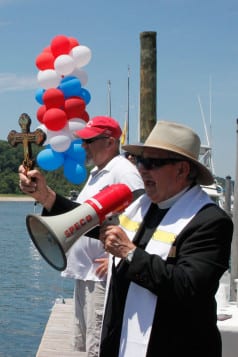Damaged doors and windows
A Village Green Drive resident in Port Jefferson Station reported the door of their 2014 Hyundai had been dented at some point between 3 p.m. on June 3 and 11 a.m. on June 4.
Two cars and an apartment on Linden Place in Port Jefferson were damaged between 5 p.m. on June 6 and 7 p.m. on June 7. According to police, the apartment’s resident reported that the vehicles’ windows were smashed and the inside of the apartment was damaged.
A BB gun pellet damaged a window at a Granada Circle home in Mount Sinai on June 7 between 5:15 and 6:15 p.m.
Taken times two
A William Street resident in Port Jefferson Station reported that cash was stolen from their unlocked 2014 Cadillac sometime around 2:35 a.m. on June 3.
A Corvette Road residence in Selden was burglarized on June 4 between 8:30 a.m. and 5 p.m. Police said the suspect entered through an unlocked rear door and took jewelry, cash and electronics.
Going through withdrawals
After stealing a pocketbook from a shopper at Stop & Shop on Pond Path in Centereach on June 3, a suspect then used the credit cards to make purchases.
A Wolfhollow Road resident in Centereach reported on June 3 that their debit card had been used to make unauthorized withdrawals.
Welts on West Broadway
A female was injured after a verbal dispute at Schafer’s in Port Jefferson became physical in the early morning of June 7. According to police, the woman had welts on her forehead after being punched and was transported to a local hospital.
Tempestuous relationship
A mother and her son’s friend got into a verbal argument on June 6 on Tempest Road in Selden.
Do not enter
A 22-year-old Bellport man was arrested in Mount Sinai on June 6 and charged with third-degree criminal trespass after he entered the backyard of a Savanna Circle home without permission on June 5.
Working for tips
A 26-year-old Centereach woman was arrested in Mount Sinai on June 5 and charged with petit larceny after she took a tip jar from Tropical Smoothie Café on May 29.
Locked and loaded
Police arrested a 43-year-old Rocky Point man on June 3 shortly after 8 p.m. after they discovered the suspect in possession of cocaine and a loaded Glock, among other weapons. He was charged with multiple related counts, including second-degree criminal possession of a loaded firearm.
Crash-and-dasher sought
Suffolk County police are seeking the public’s help in identifying and locating a woman who may have left the scene of an accident last month. Police said on May 31, at about 9:30 a.m., a woman driving a tan or beige-colored four-door sedan sideswiped a white Toyota at the Shop Rite located at 71 College Road in Selden. The suspect’s vehicle may have damage to the right front-end fender. Suffolk County Crime Stoppers is offering a cash reward of up to $5,000 for information that leads to an arrest. Anyone with information about the crime is asked to call anonymously to Crime Stoppers at 1-800-220-TIPS. All calls will be kept confidential.
Speedy DWI
A 29-year-old man from Dix Hills was arrested in Stony Brook on May 5, at 1:30 a.m., and charged with driving while intoxicated. Police said the man was driving a 2007 gray Lexus and was observed speeding on County Road 97 at Shirley Kenny Drive in Stony Brook.
Clothing grab
A 30 year-old female from Sayville was arrested on June 1 in Setauket-East Setauket and charged with petit larceny. Police said she stole clothing from Kohl’s on Nesconset Highway at 8:12 p.m. She was arrested at the scene.
Wrong side of the tracks
Someone drove onto the lawn of Crossroads Church on Pembrook Drive in Stony Brook and left tire tracks between June 5 at 5 p.m. and June 6 at 10 a.m.
Basement burglary
Someone broke into the basement window of a home on Bennett Lane in Stony Brook and took a phone, cash and credit cards sometime between 4 a.m. and 5 a.m. on June 5.
Cheat sheet
Someone took two sheet sets and returned them for credit at Kohl’s on Nesconset Highway in Setauket-East Setauket sometime between May 20 and June 6.
Lost and found
A man lost his wallet at Kohl’s in Setauket-East Setauket and someone stole it and used his credit card sometime between May 18 and May 19.
Bag grabber sought
Suffolk County police are seeking the public’s help in identifying and locating a man who broke a car window and stole a bag in Hauppauge last month.
Police said a man broke the passenger front window of a blue Toyota Rav-4 and stole a Coach handbag from within the vehicle on May 5, between the hours of 5:30 p.m. and 7:30 p.m.
The suspect appears to be a light-skinned Hispanic male, five feet and seven inches tall, in his 20s, with a medium build. The suspect was wearing a baseball hat and had his right arm in a sling.
Suffolk County Crime Stoppers is offering a cash reward of up to $5,000 for information that leads to an arrest. Anyone with information about this crime is asked to call anonymously to Crime Stoppers at 1-800-220-TIPS. All calls will be kept confidential.
Credit compromised
Suffolk County police arrested a 37-year-old man from Holbrook on June 6 and charged him with fourth-degree grand larceny of credit cards. Police said he stole credit cards from a Holbrook woman on June 4 at 8:30 p.m. He was arrested at the 4th precinct at 9:45 a.m.
Rude awakening
Suffolk County police arrested a 28-year-old undomiciled man in Smithtown and charged him with third-degree criminal trespass of enclosed property. Police said he entered a building on Maple Avenue in Smithtown on June 5 and found the man sleeping in a storage room. Police also said there was a sign on the door that cautioned no trespassing. He was arrested that day at 12:20 a.m.
Cu later
Police arrested a 24-year-old man from Ronkonkoma on June 3 and charged him with third-degree burglary. Police said the man broke into a residence on Pleasure Avenue in Lake Ronkonkoma, between April 28 and May 2, and stole copper piping. He was arrested at the 4th Precinct at 2:35 p.m.
Bike-jacked
Someone stole a BMX bicycle from a parking lot on West Main Street in Smithtown on June 7, between noon and 2 p.m. There are no arrests.
Laser gazer
A driver complained to police that someone in another car was pointing a green laser at him, causing him visual distress. The incident happened in Smithtown, eastbound on Route 25A, on June 5. The driver was traveling in a 2007 Infiniti and the suspect was a male with a female passenger.
Two heads are better than one
A man told police he was head-butted by someone at Napper Tandy’s Irish Pub on East Main Street in Smithtown on June 3. The victim said he required medical attention and stitches. The incident happened at around 11 p.m.
Donation box looted
Someone took money from the poor box at St. Patrick’s Church on East Main Street on June 2, sometime between 3 p.m. and 8 p.m. There are no arrests.
Knocked out
Police arrested an 18-year-old man from Huntington Station in Huntington on June 6 and charged him with assault with intent to cause physical injury with a weapon. Police said he smashed a bottle over somebody’s head at about 12:30 a.m. The victim had to receive stitches at Huntington Hospital. The man was arrested at 5 a.m. that day.
Teen punched
A 44-year-old man from Huntington was arrested in Huntington on June 6 and charged with acting in a manner injurious to a child below the age of 17. Police said the man punched a 14-year-old boy in the face multiple times. The incident happened on the street on Wall Street in Huntington on May 23 at 9:05 p.m. The man was arrested on West Neck Road at Gerard Street at about 11:19 a.m.
No ‘scrips, no problem
Police arrested a 39-year-old Huntington man in Huntington on June 5 and charged him with seventh-degree criminal possession of a controlled substance. Police said the man possessed prescription medication without a prescription, and he was arrested in front of West Shore Road in Huntington at 5:09 p.m.
In your face
A 23-year-old man from Huntington Station was arrested in Huntington on June 3 and charged with third-degree assault with intent to cause physical injury. Police said the man punched another man in the face, and the other individual required medical treatment. The incident took place at Ohara Place in Halesite on May 9 at 1:40 a.m., and the man was arrested at the 2nd precinct at 4:45 p.m.
Missing computer
A Knollwood Road resident in Halesite reported to police his computer disappeared from his home. He used an app to locate it and tracked the device to Brentwood. The man said he doesn’t know how it got there. The incident occurred sometime between 8 p.m. on June 4 and 11 p.m. on June 5.
Gone in a click
Someone stole a woman’s bag containing a camera, lenses, a tripod, batteries and charger sometime between 9 p.m. and midnight on June 5 on New York Avenue in Huntington. The woman left the equipment on a party bus, and when she returned to the bus, the bag was gone.
Power punch
Someone punched a man in the face on New York Avenue on June 6 at 2:35 a.m., causing him to fall back and hit his head. The man had to go to Huntington Hospital for medial treatment.
Rings taken
Someone stole two diamond rings from a home on Woodbury Road in Cold Spring Harbor sometime between June 1 and June 4. There are no arrests.



























